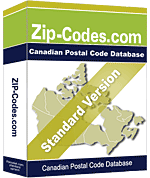How to Integrate Postal Code Data into GIS Applications
In a world driven by geographic insights, Geographic Information Systems (GIS) are essential for businesses to visualize, analyze, and interpret spatial data. Whether you're mapping customer locations, optimizing delivery routes, or managing infrastructure, GIS applications are powerful tools. To maximize their effectiveness, integrating accurate postal code data is crucial—especially when dealing with regional segmentation in Canada. This is where a Canadian zip code database proves invaluable.
Why Postal Code Data Matters in GIS
GIS relies heavily on accurate geolocation data. Postal codes are foundational units that provide structured location data for mapping, logistics, demographic analysis, and planning. By integrating a Canadian zip code database, users can create precise geographic boundaries, filter populations by region, and even develop heatmaps based on postal zones.

In sectors like urban planning, marketing, public health, and logistics, accurate postal code layers add depth to spatial datasets. This allows organizations to make informed decisions with strong geographic context.
Key Steps to Integrating Postal Code Data
Choose a Reliable Data Source
Start by obtaining a trusted dataset. The Canadian zip code database from Zip-Codes.com includes FSA and LDU codes, along with city, province, latitude, longitude, time zone, and population data.
Import into Your GIS Platform
Most modern GIS tools like ArcGIS, QGIS, and MapInfo support CSV or Excel imports. Ensure your dataset includes coordinates to allow for point plotting or polygon generation.
Create Custom Layers
With postal code data integrated, you can build custom layers for analysis. These layers can represent delivery zones, customer clusters, or service coverage areas.
Enable Geospatial Analysis
Use postal code boundaries to analyze patterns in customer behavior, product demand, or accessibility. This supports decision-making in sales, service delivery, and logistics.
Use Case for Business Intelligence
When integrated with business data, postal code GIS layers help teams identify underserved areas, manage expansion plans, or analyze competitor locations. For retail and service companies, this boosts targeting accuracy and strategic planning.
Final Consideration
Integrating a Canadian zip code database into your GIS platform opens up a world of insights, from improving service delivery to refining marketing strategies. With accurate and updated postal code data, your spatial analytics become sharper and more actionable.
For reliable datasets and easy integration, explore the tools and solutions offered by Zip-Codes.com.
Comments
Post a Comment